Media | Articles
Garden tractors are cheap, fun pathways to the vintage-vehicle hobby
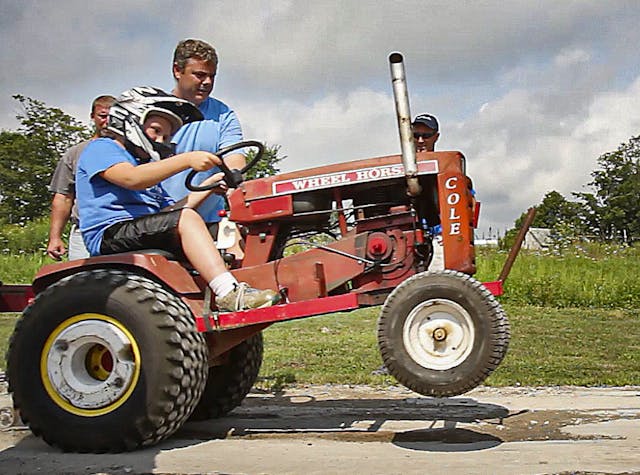
We hear it all the time: Getting kids involved in the classic car hobby is tougher than ever. How do you battle the high price of entry, especially when cost of upkeep, registration, insurance, and fuel incur their own demands?
Years ago, you’d have pointed your young classic vehicle fans to vehicles that existed on the margins: Four-door sedans and hardtops, station wagons, off-brand or weird stuff. But even these corners of the hobby have found an audience now, and the quality of collector car you can easily find for under a couple grand is pretty bleak.
There’s hope! Consider a fun, interesting, and darned useful wing of the collector vehicle marketplace that comparatively few people have explored: Garden tractors.
Look no further than your local Facebook Marketplace ads and you’ll find a garden tractor for sale that afford with returnable can money. Larger tractors like the Ford 8N have a passionate audience, but they do take up a lot of space, and they’re not cheap any longer. So, as Volkswagen used to say, think small.
Garden tractor enthusiasts prize their workhorses for their utility, but there are also contingents of fans that are using them for pulling competitions and for racing.
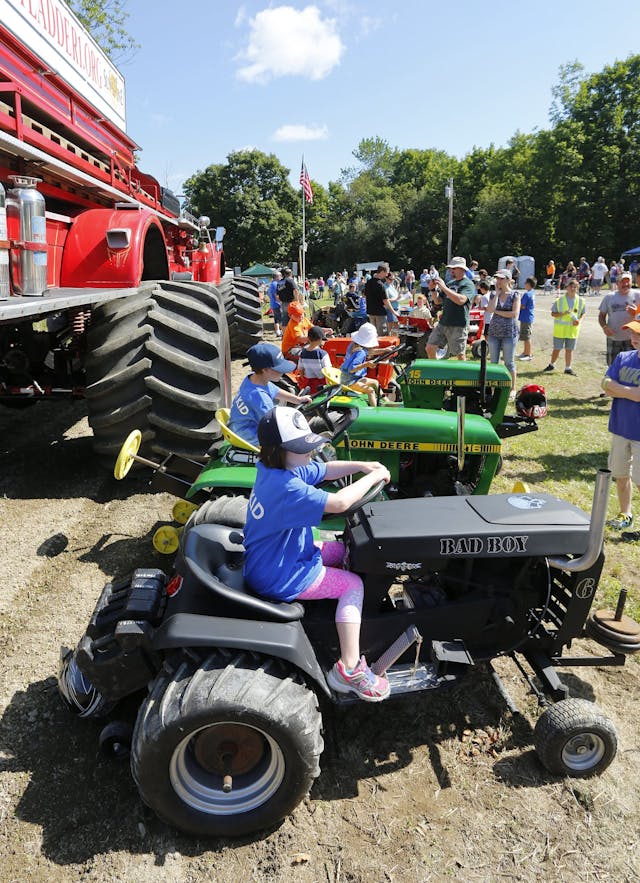
Lawn tractor or garden tractor?
You may not think so, but there is a difference between a lawn tractor and a garden tractor. Lawn tractors are more or less lawn mowers with a deck. They might have a bagger attachment on later versions, but their primary purpose is cutting the grass.
A garden tractor may indeed have a cutting deck, but it is also suitable for a range of attachments, from snowplows to snowblowers, and some might even have hydraulic buckets, three-point hitches, or PTO (power take-off) provisions for a wide range of light implements.
David Bradley and the garden tractor in America
You can’t talk about garden tractors—or any other kind of home implement from this period—without discussing David Bradley. Bradley was a manufacturing powerhouse at the turn of the 20th century, in the brick, lumber, and farm machine trades. In 1884 he purchased a plow manufacturing company, bought out his partner, and launched the David Bradley Manufacturing Company. In 1895 Bradley relocated the outfit to North Kankakee, Illinois, which was renamed Bradley City (shortened to Bradley by 1896) in his honor.
The bigtime hit in 1910, when he sold his manufacturing company to Sears, Roebuck and Company. For decades after, all of the home improvement equipment that Sears, Roebuck and Company sold was under the aegis of David Bradley: Lawnmowers, saws, utility trailers, rototillers, everything. Before there was Craftsman, there was David Bradley.
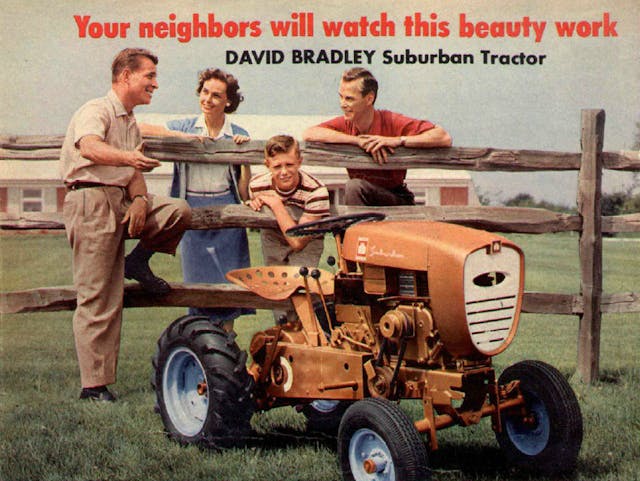
The David Bradley line of products included a garden tractor in 1958, and the company quickly became the world’s largest manufacturer of these little dynamos. In 1962, the David Bradley Manufacturing Company and the Newark Ohio Company merged under the latter’s name. Two years later, the Newark Ohio Company merged with the Geo. D. Roper Corporation, which went off producing its own brand of products, as well as those for Sears.
The Golden Era of garden tractors
Garden tractors really hit their stride as Americans pushed out from the cities into the suburbs and beyond. Wheel Horse began offering its small Ride-Away garden tractor as early as 1947, hitting its stride in the mid-1950s.
Based on the success of Wheel Horse and David Bradley, manufacturers like John Deere and Cub Cadet hit the scene in the early 1960s as the true golden era of the garden tractor really took off. From there, the list of garden tractor brands exploded, with entries from Colt, Economy, Ingersoll, Case, Oliver, Snapper, Simplicity and an endless array of other brands selling from bespoke agencies all the way to your local hardware store.
Gear drive or hydrostatic?
Outside of which brand of garden tractor you’re interested in, the big variable you’ll run into is the type of transmission.
Early garden tractors almost always had a conventional gear-driven transmission with a clutch and three or four speeds, sometimes with a low range for crawling and plowing. They’re simple and, with basic fluid changes, almost bulletproof.
A hydrostatic transmission uses hydraulic fluid in a variable displacement pump. While they operate on a completely different principle, you can think of a hydrostatic transmission like a continuously variable transmission; the engine turns at a constant speed while the operator sets the ground speed with a lever. Lacking a clutch pedal, they’re easy to operate and their ability to set a constant speed in small increments is suitable for lawn mowing, in particular.
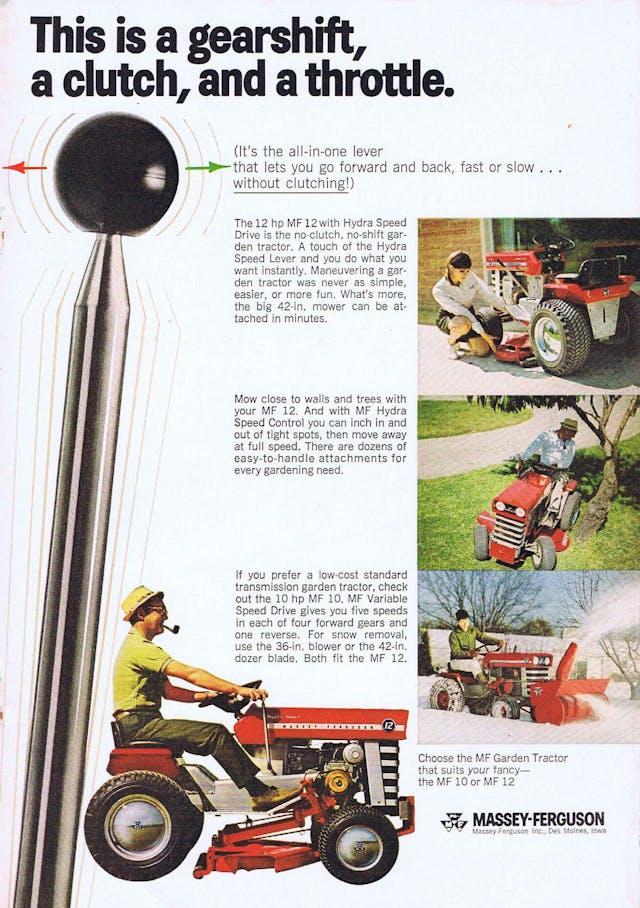
A hydrostatic transmission, however, is less serviceable in the hands of a home enthusiast. And while they can operate a power take-off (PTO), they don’t transfer horsepower from the engine with the same efficiency.
So who are the big players? It’s impractical to cover all the brands in the mix here, but we’ll hit a few of the most popular with active club support and parts suppliers:
John Deere
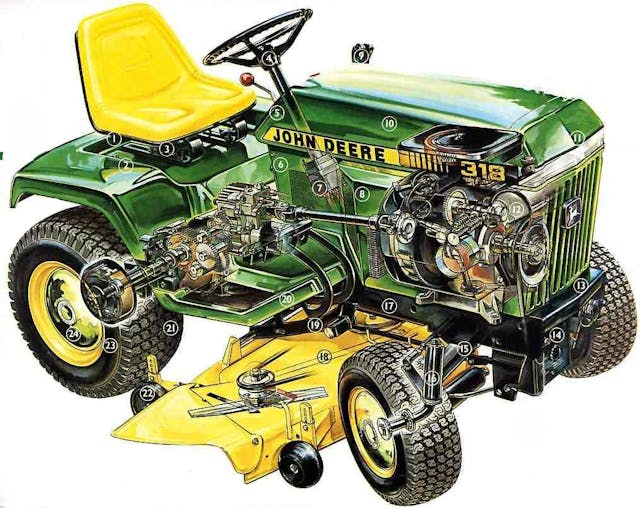
Deere was kind of a Johnny-come-lately in the garden tractor market, but today it’s recognized as the leader—and for good reason. Its 1960s- and 1970s-era garden tractors are prized by collectors and still working hard in yards and small farms all over the country.
There are over 400 different models of John Deere garden tractors. The most iconic was the 300 Series. Built between 1977 and 1992, the 300 series began with the 312 with a 12-hp single, all the way up to the 332 with a 16-hp Yanmar three-cylinder diesel.
A running and operating 300 series today can range from around $400 for a running project 312 up to somewhere around $3000 for a nicely restored or original 322 with the Yanmar diesel.
Cub Cadet
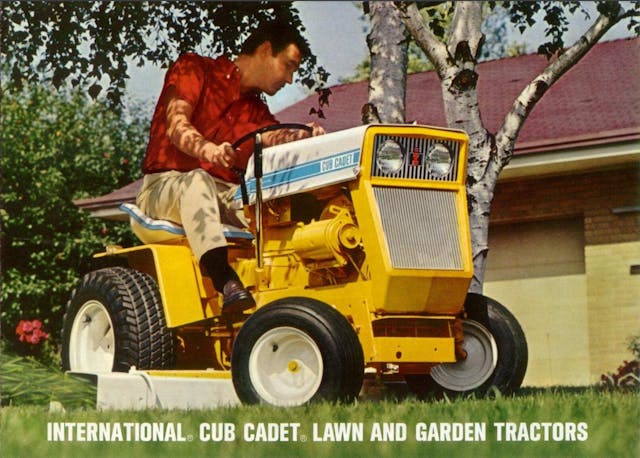
International Harvester entered the garden tractor market in 1961 with a model that’s now come to be known as the Original, a small tractor powered by a Kohler 7-hp single. Since then, there have been hundreds of Cub Cadet models, but many collectors are interested in the pre-1981 garden tractors, built when Cub Cadet was still under the International Harvester brand, before the company’s sale to MTD.
Cub Cadet’s 100 Series was produced between 1963 and 1984 and featured engines from 10hp all the way up to 16 hp. The 149— built between 1971 and 1974—is relatively plentiful, has good parts availability and has the look of a peak period garden tractor. Attachments like plows, tillers, and buckets are available. You can find a running 149 in the $500 range. Fully restored tractors would set you back $1500–$2000.
Wheel Horse

Wheel Horse arrived early in garden tractor history when Elmer Pond began building small tractors in a barn in 1946. The brand made hundreds of models over the years, but enthusiasts are particularly interested in those built before 1986, when Toro purchased the company.
Most plentiful are the C-Series tractors built between 1971 and 1984. A good example is the C-160 featuring a giant cast iron Kohler 16-hp single and a four-speed (including reverse) gear drive transmission with a low range.

The pictured C-160 was recently purchased running and fully operating for $800 including the manual angle plow and tire chains for snow plowing. A nicely restored C-160 could run into the $1500–$2000 range, especially with attachments like snowblowers and tillers. There’s even a rare hydraulic bucket attachment that could easily double the price of a good tractor.
Ford
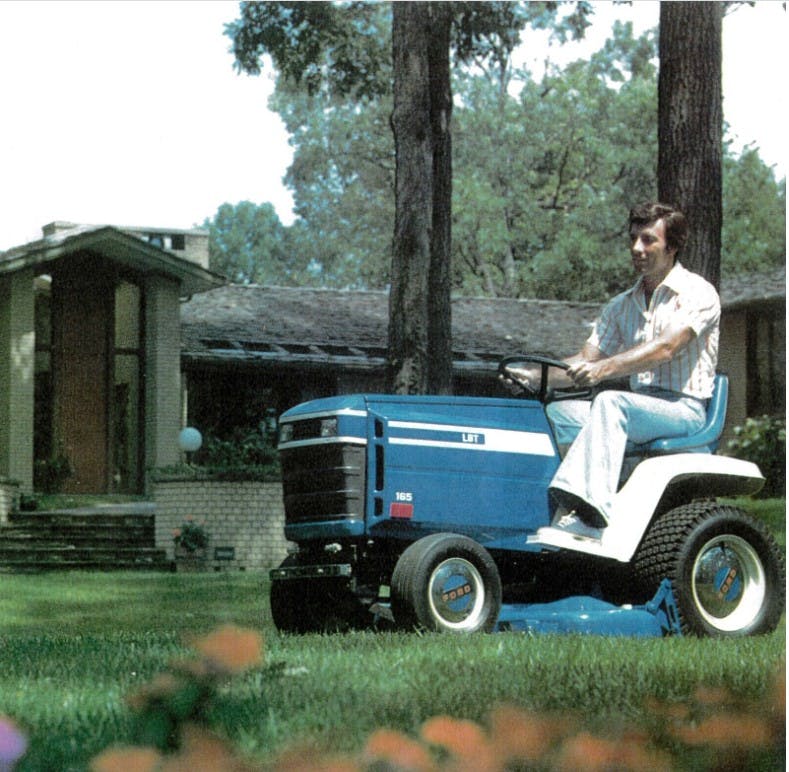
We mention Ford here mostly because the brand obviously crosses over with vintage car people and culture. Anyone with a first-gen Mustang would be proud to have a Ford LGT garden tractor in the collection. In fact, in Ford advertising the LGT 120 was referred to as the home improvement implement for “Mustang people with lawns.”
Mind you, Ford wasn’t a manufacturer of garden tractors. It contracted production out to a range of conventional garden tractor companies like Jacobsen and Toro before the brand was entirely replaced by New Holland in 1988.
Peak years for the LGT were between 1972 and 1983, with models ranging from the 12-hp LGT-12 to the 19-hp LGT-195. Depending on size and condition, you can find an LGT in the $500 range for a running and operating LGT-12, into the $1250 range for a nicely restored LGT-145.
Sears
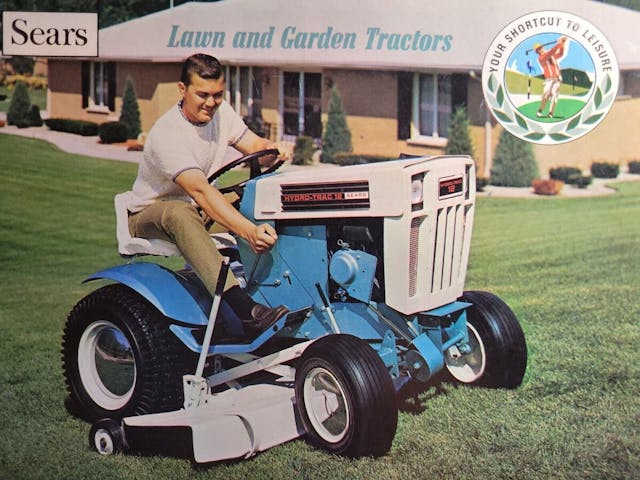
After its initial lineup of David Bradley tractors, Sears, Roebuck and Company began offering the Sears ST line of tractors in the early 1970s, before it unleashed the GT series in 1985.
Like Ford, Sears wasn’t a manufacturer of tractors, but contracted with builders of some of the best equipment available at the time. The GT series in 1985 was produced by Roper and was—at the time—a pricey $2500, featuring an 18-hp Briggs & Stratton twin and a six-speed gear-drive transmission.
At one point, these tractors were known as the Craftsman II, and they came in a variety of sizes. They’re generally regarded as tough, solid tractors with a wide range of attachments.
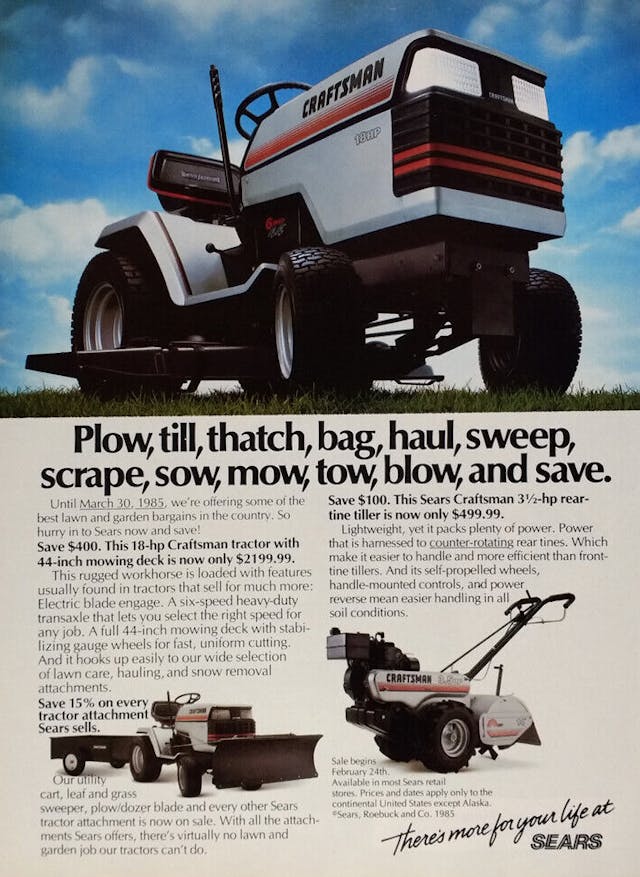
If you’re on the hunt for a Craftsman tractor, you can find a GT 18 just about anywhere in the $1000 neighborhood, depending on the condition and the attachments it comes with.
For much more detailed information on vintage garden tractors, Tractor Data has tons of information on production history. Forums and Facebook groups for every brand and variety of garden tractor are a great resource for parts, tractors for sale and DIY information. Happy riding (and wrenching)!
***
Marketplace
Buy and sell classics with confidence
Check out the Hagerty Media homepage so you don’t miss a single story, or better yet, bookmark it. To get our best stories delivered right to your inbox, subscribe to our newsletters.















I have a Gravely, 2 wheel so u walk behind her. Grass, snow rotor till this old machine dies it all. Rope pull start is a bit of a pain.
And, my go to machine is the Wheel horse hydro 18hp, big twin., 52″ deck
Around 1996 I think, parts are easy to find but have to go south if the border to get em.
There is a huge following for wheel horse/Toro machines
Used to have a large Wheel Horse dealer in northern NJ and as a youngster loved going there to see their new offerings in the early ‘70’s
My dad bought a Wagner tractor in the late ‘60’s with a mower deck, a plow blade & later my dad bought a Craftsman snowblower attachment and fabricated mounts and a drive belt system and used it into the late ‘80’s for snow removal
All those old mowers. I think I can top some of them. I have a 1988 Yamaha Tera Pro. Grant it, it’s a 4 wheeler, 2 wheel drive with with unlocking rear differential. It is designed for mowing yards. Has PTO for running a 48”, 2 point hitch pull behind. It has a standard transmission. I bought it new in 1990 from Lineman Cycle. This will be my 34th year coming up for mowing my yard. About 1 1/2 hours of mowing each time. They only made the Yamaha Tera Pro one year. I’ve seen a couple sites where people collect these being made only the one year. Sorry about the novel but thought it was worth sharing.
I have a Yamaha Terrapro also. I bought it at Dutchess Recreational Vehicles in Poughkeepsie with a Woods built Yamaha RC-42 brush hog deck. It’s a great setup and it’s too bad it never caught on in big numbers. The Yamaha model is YFP350U and I always enjoy the occasional fun after disconnecting the brush hog. My UPS delivery guy liked mine so much he bought one with deck I think you have, the Woods built Yamaha FM-48 finish mower deck. We ended up swapping decks because he needed a brush hog so I borrowed his finish mower. Interesting note, my Terrapro is a 1987.
I believe there was also a tiller attachment available.
I was hesitant to buy it at first because I was worried about engine cooling but the ducted, fan driven cooling fan kept the engine cool.
It’s great to hear someone else has one of these.
We looked seriously at those, before buying our 1988 Deere 185. Seems like they had available a pull-type 48″ finish mower, a 42″ rotary cutter, and a tiller – right? I guess Yamaha only made them the one year because they did not sell well; I recall seeing only one in the past 30 years or so, and that was at a Yamaha motorcycle dealer, I think.
I sought out, and restored a 1991 John Deere 430 diesel. IMO, the holy grail of JD’s. It’s the Hemi Cuda, the LS6 of the garden tractor world. It is @1/3 bigger in scale than the models above. 3 cyl Yanmar diesel, full hydro drive, front/ rear PTO, 3 hyd ports, hi/lo range, locking rear diff, full power steering, etc, etc. It has a 60″ deck that I also restored. Nothing like it – in power, size. Everything a full tractor has, this has it but much smaller package. I love it!
We still have our Deere 185, bought new, and it still cuts well. It has needed some work over the years (and over 1000 hours), but in fairness, it was a lawn tractor used for heavier duty. We dragged 12-15 inch fallen trees behind it, pulled an 800 pound load in a Deere #10 cart, and it even helped pull a car out of the mud once. Its only real issue over the years has been its lack of traction on some surfaces. To date, its Kawasaki 17-hp Single has needed only a carb rebuild, and the hydro drive has needed nothing – not even fluid adds.
Before buying it, we also shopped the article-mentioned Ford lawn tractors, the Simplicity Sun Runner, and the Yamaha Terrapro.
I have a Wheel Horse 800 Special I bought in 1970, 36 inch mower deck, and a snow blower for $800.00, she still runs today but is retired. Replacement is a John Deere X728. 4 wheel drive beast. Less than 285 hours on her, it’s a good machine but the wheel Horse still looks great, who waxes there tractors?? Both are show room shape, and both have been worked hard over the years. All depends how you take care of you stuff.
Very interesting thought process on getting the young folks interested in machinery and then the car hobby. Also a very good way to get started restoring a project. A simple avenue and a quick restore project. That will give you pride in the project quickly.
I have a JD 318 and mow with it in the summer every week. Maybe I should take better care of it if it is a classic. It is a Workhorse (pardon the name) I have had it for over 20 years and still starts up every spring. I like the power steering and the hydrostatic transmission.